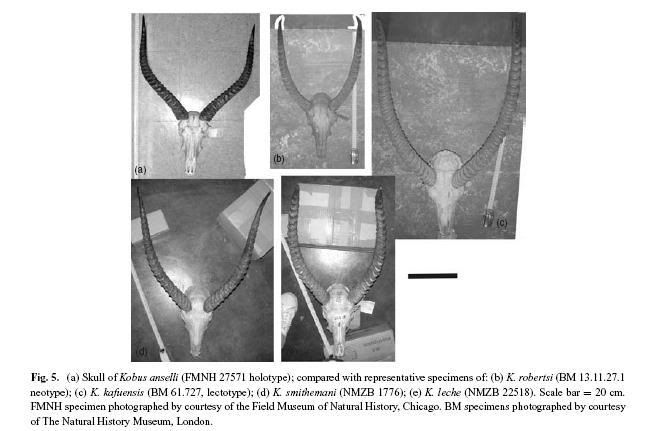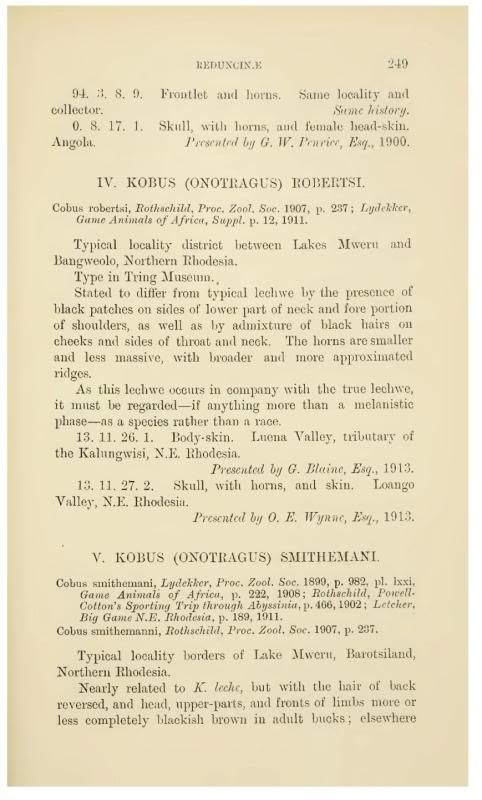|
|
Post by Peter on Apr 16, 2005 16:50:48 GMT
This subspecies of the Lechwe from Zambia is now extinct. Does anyone know when?
|
|
|
|
Post by another specialist on May 9, 2005 17:55:04 GMT
Red List Category & Criteria EX ver 2.3 (1994)
Year Assessed 1996
Assessor/s Antelope Specialist Group
History 1994 - Extinct (Groombridge 1994)
|
|
|
|
Post by sebbe67 on Aug 6, 2005 10:06:38 GMT
hard to tell, as none seems to tell the correct date of extinction.
I have looked after much info about this mammal, but I havent found anything.
|
|
|
|
Post by another specialist on Aug 7, 2005 3:37:51 GMT
hard to tell, as none seems to tell the correct date of extinction. I have looked after much info about this mammal, but I havent found anything. Yes, it hard to tell they either represent this subspecies or another similiar or hare showing in pure/hybrids or introduced stocks? Can't find any extinct date really |
|
|
|
Post by Melanie on Aug 7, 2005 12:15:11 GMT
Yes that is really hard to tell as we have at least 4 different subspecies of Kobus leche in Zambia.
|
|
|
|
Post by Melanie on Aug 7, 2005 21:59:42 GMT
The point is that some scientists regards the Roberts' Lechwe as synonym of the Kafue Lechwe. But when i am comparing the photos of both species i must say the coat of the Kafue Lechwe is much brighter than the coat of the Robert's Lechwe. |
|
|
|
Post by another specialist on Aug 8, 2005 3:45:12 GMT
Interest Melanie thanks for the info
|
|
|
|
Post by sebbe67 on Nov 3, 2005 19:51:37 GMT
Yet another race, Kobus leche robertsi, native to the Luongo and Luena River drainages of northwestern Zambia, is now extinct.
|
|
|
|
Post by another specialist on Nov 3, 2005 19:53:56 GMT
were was the above sourced from?
|
|
|
|
Post by sebbe67 on Nov 3, 2005 19:58:29 GMT
Walker, mammals of the world
|
|
|
|
Post by another specialist on Nov 3, 2005 20:00:30 GMT
thanks sebbe67
|
|
|
|
Post by sebbe67 on Mar 13, 2007 18:57:11 GMT
There photos of a skull with horn and a skin (both in black-and-white in the pdf
The Upemba lechwe, Kobus anselli: an antelope new to science emphasizes the conservation importance of Katanga, Democratic Republic of Congo
Though they list it as a seperate species, Kobus robertsi. Apparently known from very few specimens, with only two examined during the above study.
A bit of info from above pdf:
Kobus robertsi Rothschild 1907, restricted to the Pambashye Swamps, Luongo-Kalungwishi drainage system (Cotterill 2003).
There is much more info about it and will be post more later, the pdf is on 132 pages so its alot of reading to be done ;D, all of it higly intresting as its a taxanomic review of the entire lechwe group.
|
|
|
|
Post by another specialist on Mar 13, 2007 22:24:41 GMT
Sebbe67 is this pdf file on the net or have you purchased it?
As I would love to read this one myself.
|
|
|
|
Post by Bhagatí on Mar 14, 2007 23:32:20 GMT
|
|
|
|
Post by another specialist on Mar 16, 2007 16:19:03 GMT
Sebbe67 is this pdf file on the net or have you purchased it? As I would love to read this one myself. Thanks for the file sebbe   |
|
|
|
Post by another specialist on Jul 14, 2008 5:43:17 GMT
SPECIES Kobus leche Author: Gray, 1850. Citation: Gleanings, Knowsley Menagerie, 2: 23. Common Name: Lechwe Type Locality: "Banks of the river Zoaga, lat. 21°"; since identified as Botswana, Botletle River, near Lake Ngami (Smithers, 1971:233). Distribution: SE Angola, N Botswana, SE Dem. Rep. Congo, NE Namibia (Caprivi Strip), and Zambia. Status: CITES – Appendix II; U.S. ESA – Threatened; IUCN – Extinct as K. l. robertsi, Vulnerable as K. l. kafuensis and K. l. smithemani, Lower Risk (cd) as K. l. leche. Comments: Revised by Ansell and Banfield (1979). Consists of four evolutionary species according to Cotterill (2003a), namely K. leche, K. kafuensis, K. robertsi, and K. smithemani.www.bucknell.edu/msw3/browse.asp?s=y&id=14200984 |
|
|
|
Post by another specialist on Apr 28, 2009 22:31:53 GMT
 Catalogue of the ungulate mammals in the British Museum (Natural History) (1913) |
|
|
|
Post by Peter on Dec 25, 2011 9:34:32 GMT
I know I did ask this question also in 2005, but now I'm busy with creating a new database with all species including the extinction dates (the mammal part is almost finished, and I will share it with you all), I see I still can find out when this animal became extinct. Has someone else many meanwhile found something somewhere?
|
|
|
|
Post by Peter on Dec 25, 2011 10:05:09 GMT
Source: Chapter 7. Morphology and molecular phylogeny. in: Cotterill, F.P.D. 2006. The Evolutionary History and Taxonomy of the Kobus leche species complex of south-central Africa in the context of Palaeo-drainage Dynamics. Unpubl. PhD Thesis, University of Stellenbosch. You can download the whole thesis from: sites.google.com/site/fpdcotterill/research/lechwe-antelops. It also include the images of the skins posted here before, but this time in colour. Kobus robertsi Rothschild Cobus robertsi Rothschild 1907 Proc. Zool. Soc 237 The provenance and type material of Kobus robertsi has been the source of mystery soon after its original description. Ansell (1974) recalls how as a young lieutenant, Colonel O. E. Wynne was tasked in January 1913 by Lydekker and Blaine to collect a specimen of Robert’s lechwe for the BM(NH) mammal collection as the original type had been lost. Wynne subsequently collected BM 13.11.27.1 on 7th October 1913 from the Luongo River (Appendix 1). Thus, the type locality was restricted to 10o 35'S, 28o 59'E by Ansell (1974). The identity, provenance and current whereabouts of the Holotype (a mounted head) lies at the centre of persisting mystery. Recent research by Dr P. J. Grubb on Lord Rothschild’s correspondence, archived in the BM(NH) has clarified the identity of the collector, Mr Frederick Russell Roberts who collected and sold the original specimen to Rothschild (through the taxidermists Rowland Ward). Nonetheless, the holotype cannot be traced as of 2004 (P. J. Grubb in litt). A mounted head, this Holotype was exhibited at Tring, where it was seen by Ansell (1974) who identified as a mis-labelled specimen of K. smithemani. This specimen appears to have been moved from Tring to the Wandsworth storeroom of the BM(NH) in London (P. J. Grubb in litt.). It is listed in the BM(NH) catalogue (Tring mammal collection) as “Cobus robertsi % head 39.4671". This is presumably the same specimen, that Ansell (1974: 20) mentioned that he saw labelled “Robert’s Kob, Cobus robertsi, N. E. Rhodesia” (his misquoted number BM 39/3671). This specimen cannot now be located in the BM(NH) collections (P. J. Grubb in litt). All literature sources reiterate that the type of robertsi came from between Lakes Mweru and Bangweulu. Lydekker (1908) considered robertsi an immature smithemani; but later noted that Lord Rothschild has informed him that "C. robertsi appears, indeed, to come closer to C. leche than to C. smithemani; and is found in company with the former, from which it differs ...." Lydekker (1911: 12). This conclusion was reinforced by Blaine’s and Wynne’s specimens from the Kalungwishi and Luongo rivers, respectively (Lydekker & Blaine 1914: 249). The practicable solution to this problem has been to continue to follow Lydekker (op. cit.) and Ansell (1974), and apply robertsi as the name available for the now extinct population of lechwe that occurred through the Luongo-Kalungwishi drainage systems (collectively named the Pambashye Swamps). Nevertheless, the Holotype of robertsi might still exist, and is presumably the mounted head seen at Tring by Ansell (1974), but identified as a smithemani, which cultivates the suspicion that Rothschild’s robertsi might indeed be a synonym of smithemani. This would mean that the extinct population of the Pambashye Swamps has actually vanished undescribed! On going historical research on Joseph Edward Hughes (1876 - 1935) who wrote the classic Eighteen Years on Lake Bangweulu (Hughes 1933) might hopefully clarify where F. R. Roberts travelled and collected in northeast Zambia. This was probably in 1903 (P. J. Grubb in litt.). The Neotype (BM 13.1.7.11) formed the single representative of this taxon in morphometric comparisons of male lechwe in this study, following on Ansell & Banfield (1979). Two flat skins were also studied. DNA from BM 13.1.7.11 was successfully amplified for markers used in the genetic section of this study, and in the phylogeographic study alongside two other specimens (Chapter 6).
|
|
|
|
Post by Melanie on Dec 25, 2011 20:09:33 GMT
I know I did ask this question also in 2005, but now I'm busy with creating a new database with all species including the extinction dates (the mammal part is almost finished, and I will share it with you all), I see I still can find out when this animal became extinct. Has someone else many meanwhile found something somewhere? Well, even HMW2 statet that the extinction date is unknown. So sometime in the 20th century. |
|